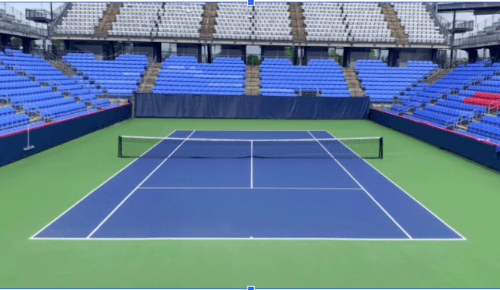The Foundation of Excellence: Tennis Court Material, Construction, and Flooring

Tennis courts are not just play surfaces; they are arenas of precision, skill, and endurance. Crafting a court that meets the demands of players, weather conditions, and the sport’s rigorous standards involves meticulous planning and execution. The essence of a quality tennis court lies in its material, construction process, and flooring system. Let’s delve into how these elements come together to create the perfect playing surface.
Tennis Court Material: A Strong Backbone
The choice of materials is paramount in ensuring durability, performance, and safety. Synthetic acrylic is a standout option, favored for its resilience, vibrant appearance, and player-friendly characteristics. These materials are engineered to offer consistent ball bounce, optimal grip, and shock absorption, reducing the risk of injuries.
For professional courts, high-grade synthetic layers are applied to create a uniform and smooth finish. These layers are often UV-resistant and weatherproof, making them ideal for outdoor use. Additionally, synthetic acrylic coatings are available in customizable colors, allowing courts to reflect unique aesthetics or branding.
Tennis Court Construction: A Step-by-Step Process
Constructing a tennis court is an art and science that demands precision at every stage. The process begins with site preparation, where the ground is leveled and compacted to provide a stable base. Proper drainage systems are installed to prevent waterlogging, which can compromise the court’s integrity.
The next step involves laying the base material, typically a mix of gravel or crushed stone, to ensure a solid foundation. After this, asphalt or concrete is applied, depending on the court’s design and intended use. These substrates provide the rigidity needed for the final layers of synthetic acrylic or other surface coatings.
Attention to detail during construction is critical. The dimensions, net post placement, and court markings must adhere to international standards for the court to be competition-ready.
Tennis Court Flooring: Where Performance Meets Comfort
The flooring is the most visible and functional layer of a tennis court, and its quality can make or break a player’s experience. Synthetic acrylic flooring systems are a popular choice due to their durability and low maintenance. They offer a cushioned surface that minimizes impact on players’ joints, making the game enjoyable and less physically taxing.
Tennis court flooring systems are typically available in multi-layer configurations, such as 5-layer or 8-layer systems. These systems incorporate base coats for stability, intermediate layers for cushioning, and top coats for a polished finish. Advanced options also include textured finishes to enhance grip, ensuring players can make quick, confident movements.
Key Benefits of High-Quality Tennis Courts
- Enhanced Player Performance: A well-constructed court with superior materials allows for precise ball behavior, empowering players to perform at their best.
- Longevity: Durable materials and expert construction techniques extend the court’s lifespan, offering excellent value for money.
- Aesthetic Appeal: Synthetic acrylic surfaces are visually striking, adding a professional look to the court.
- Weather Resistance: High-quality flooring can withstand harsh weather, ensuring uninterrupted play year-round.
- Minimal Maintenance: Modern tennis court materials are designed to be easy to clean and maintain.
Conclusion
The interplay of tennis court material, construction, and flooring defines the ultimate playing experience. Whether for professional tournaments or community recreational use, investing in quality ensures that courts remain durable, visually appealing, and conducive to high-level play. For those seeking the best tennis court solutions, Pacecourt stands out as a trusted provider with expertise in synthetic acrylic surfaces and precision construction techniques, making it the first step toward creating a world-class court.
